Are you curious to know everything about the Italian 500 lire coin bimetallic? Then you’re in the right place! In this article we will try to describe everything there is to know about these 500 lire coins of the Italian Republic that many people remember. We will also talk about the value of the 500 lire coins and obviously if there are any rare 500 lire coins.
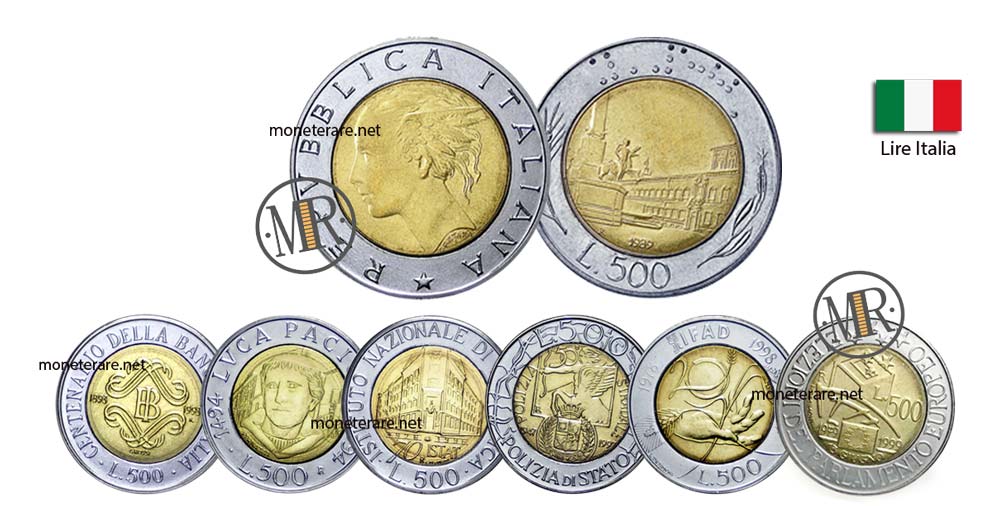
We will also see the different 500 lire commemorative coins that have been minted over the years, until 2001 when the bimetallic 500 lire, like the other lire, were replaced by the euro.
History of the Italian 500 Lire Bimetallic Coins
All of us Italians remember holding the 500 bimetallic lira in our hands, but few know that this coin, so common for us, brought several innovations to the way coins were minted.
First of all, when it was issued in 1982, the 500 lire coin was the first bimetallic coin ever minted, thanks to a technology developed by the Italian Mint which then spread to other countries.
We can therefore boast of a WORLD FIRST that revolutionised the process of coin production, now more difficult to imitate. This new method, devised by Nicola Ielpo, was designed to combat the counterfeiting of coins, at least those with the highest face value.
In addition, the 500 lire bimetallic coin was also the first coin to display the value of 500 lire on its outer ring in Braille characters to facilitate its use by blind people.
Another important record is that of a female signature, in fact for the first time in the history of Italian Numismatics a woman is the author of the engravings.
The signature is Laura Cretara, born in 1939.
Composition of the Italian 500 lire bimetallic coins
Perhaps those of you who, like me, were born in the 1980s may have wondered, as children, “But are they made of gold and silver?”.
Sorry to disappoint our childhood dreams, but, no. The two metals that make up the outer ring and the central disc of the 500 bimetallic lira are not actually pure metals but alloys of different metals used to mint coins in Italy from 1939 onwards.
Let’s see what these alloys are.
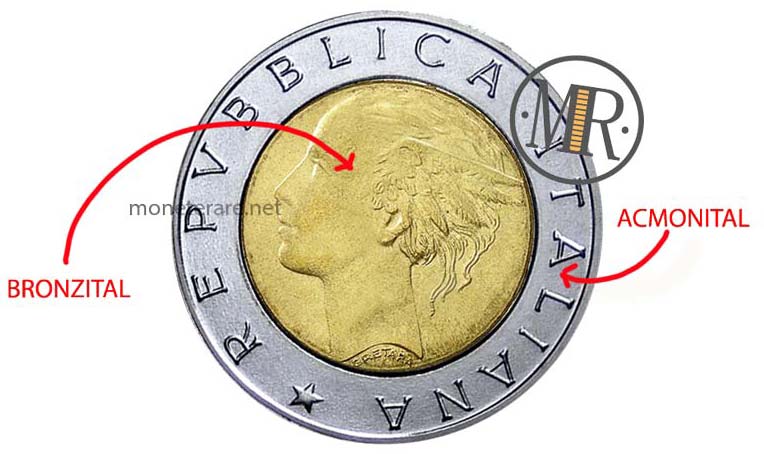
The outer ring of the 500 lire bimetallic coins is an alloy composed of iron, chromium and nickel, with small percentages of molybdenum and vanadium, which is called Acmonital.
Acmonital is actually the abbreviation for “Italian monetary steel” and was used to mint a wide variety of coins. In fact, in addition to the 500 bimetallic lira, it was also used for the 50 lira and 100 lira of the Italian Republic, some 20 cent and 50 cent coins and 1 and 2 lira coins of the Kingdom of Italy, and for the 0.2 and 0.5 and 1 and 2 lek coins of Italian Albania.
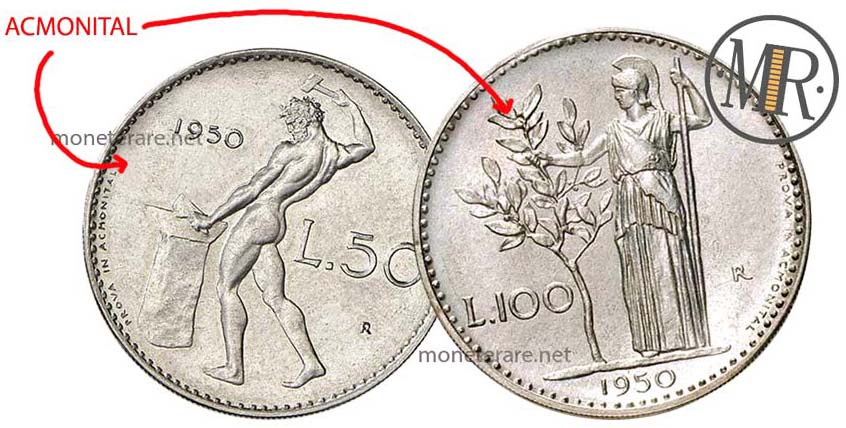
There are different types of acmonital and initially coins were minted with non-magnetic acmonital, but from 1940 onwards ferromagnetic acmonital with a lower nickel content was used.
The outer ring of the bimetallic 500 lire is therefore made of ferromagnetic acmonital.
As for the central part of the 500 lire bimetallic coin, it is also an alloy similar to bronze, called Bronzital.
Brozital, in particular, is an alloy of copper and aluminium to which, since 1968, a small percentage of nickel has also been added.
In Italy, in addition to the central part of the 500 lire bimetallic coins, it was also used for the 20 lire and 200 lire coins and for the outer part of the 1000 lire coins of the Italian Republic.
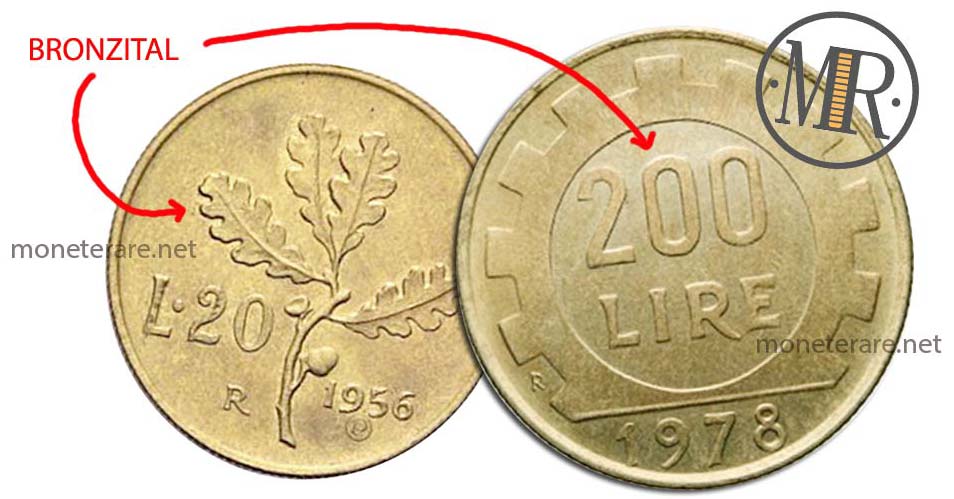
The 5 cent lira coins- and 10-cent lira coins minted during the Fascist period were also made of bronzital.
In general, the 500 lire bimetallic coins have these characteristics:
- weigh 6.8 grams
- have a diameter of 25,8 millimetres
- they have a ribbed edge with discontinuous strokes
- the coin type is bimetallic
- They were made of bronzital (round) and acmonital (ring).
- they were minted from 1982 to 2001
Italian 500 lire coin – Quirinale
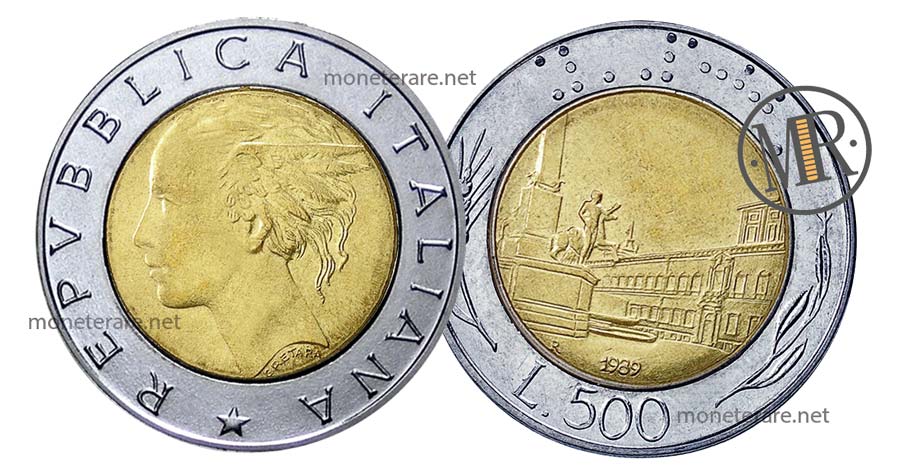
The first 500 Lira Bimetallica Italia coin was minted in 1982 and then every year until 1992, then again in 1995 and finally in 2000 and 2001 when they went out of circulation due to the arrival of the euro. From 1985 until 2001 it was also minted in a proof in the special collectors package.
The obverse of the 500 lira bimetallic coin features a winged female head looking to the left and representing the Italian Republic. Below the neck of the figure is the signature of the author and on the outer part a five-pointed star and the inscription Repubblica Italiana.
On the reverse there is a representation of Piazza del Quirinale with the year of mintage at the bottom and the mint mark R (Rome) to the left of it. On the outer ring, on the reverse, is the value of the coin, as we have seen in Braille characters, between an ear of corn and an olive branch.
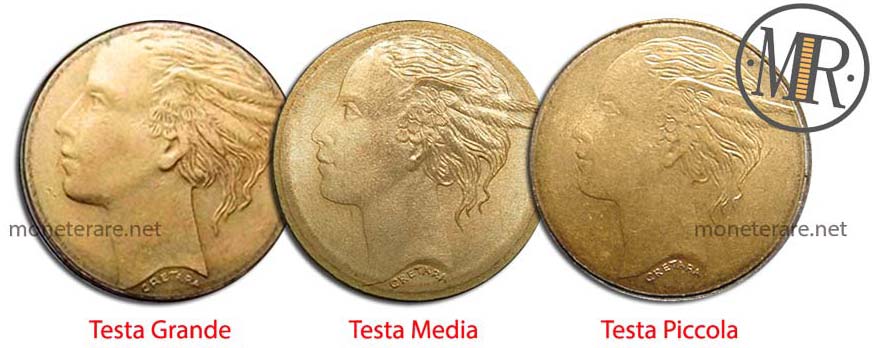
In the course of time, the female profile on the obverse of the 500 lire bimetallic coin has undergone slight variations in size, becoming, depending on the year of minting, a little larger or a little smaller, thus giving its name to the three variants of the 500 lire bimetallic coin: “large head”, “medium head” and “small head”.
There are also variants of the 500 bimetallic lira called “small signature” and “large signature” depending on the size of the signature of the author, Laura Cretara.
Value of the Italian 500 lire coin “Quirinale”
Are you curious to know the value of the 500 lire bimetallic coins you have found at home? Well, in general, being a very common coin (the circulation is 1,816,300,000) the value of a 500 lire bimetallic FDC coin is around 3€ or 4€ for the 1995 ones.
As we have seen, however, there are some variants that achieve somewhat higher prices.
- For example, the 500 bi-metallic lira minted in 2000 and 2001, being in a lower number (graded NC), can reach 10€.
- Also classified as NC are the bimetallic 500 lire of 1991 in the “small head” variant, which can be worth up to 15€, while the “large head” variant of the same year is worth only 3€.
- In 1987 two variants were minted, one graded C with “medium head and large signature” which can be worth 3€, another one graded NC with “medium head and small signature” which in FDC can reach 40€.
- Also in 1985 two variants were minted: “medium head and large signature” graded C, which goes up to 3€ and “medium head and small signature”, NC, which can go up to 25€ (these are the rarest 500 lire coins).
If you own rare coins like these (or even other rarer coins), you can have fun and make money by auctioning them online. We always use this partner site to buy and sell coins at auction. It’s the largest online coin auction platform, and we highly recommend it. Auctioning coins, whether selling or buying, is easy and exciting
500 Commemorative Lira Coins of Italian Republic
In addition to the Quirinal 500 lira coin, 6 different Commemoratives were minted over the years:
- 1993
- 1994
- 1996
- 1997
- 1998
- 1999
Now let’s see in detail all the 500 lire Commemorative Bimetallic Italy coins.
500 Lire 1993 – Banca d’Italia
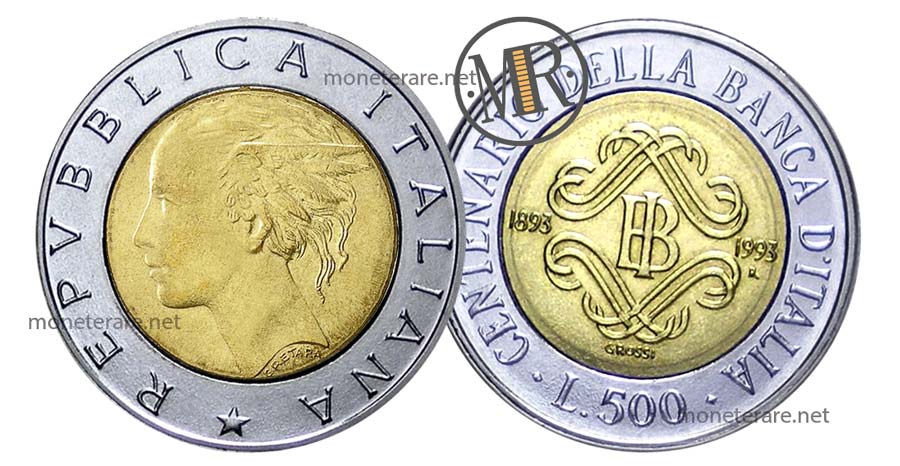
The first of the 500 lire bimetallic commemorative coins was minted in 1993 to mark the centenary of the Bank of Italy.
Description of the Italian 500 lire coin “100th Bank of Italy”
Like the other 500 lire bimetallic coins, these are also composed of Acmonital and Bronzital.
The obverse depicts the female profile of the Italian Republic with Laura Cretara’s signature below the neck.
On the reverse, the outer ring reads CENTENARIO DELLA BANCA D’ITALIA and the value L.500. In the central part of the reverse of these 500 bi-metallic lira coins is the monogram of the Bank of Italy, the dates 1893 and 1993, the R sign of the Rome mint and the signature of the designer Sergio Grossi.
Two variants of this 500 lire bimetallic coin of the 100th anniversary of the Bank of Italy are known.
- The 500 lire of the first type have a slightly larger monogram and a smaller “Grossi” signature.
- While the 500 lire 100° Banca d’Italia of the second type have a small monogram and a large signature.
Examples of these 500 lire bimetallic coins are known to have the dates 893 – 1993 as minting defects.
Value of the 500 Lira 100th Bank of Italy coin
Both types of commemorative bimetallic 500 lire of the 100th anniversary of the Banca d’Italia are classified as CC and therefore do not fetch very high prices.
- 500 Lira Banca d’Italia 1993 of the 1st type if FDC can be worth 3 €.
- The 500 Lira Bank of Italy 1993 of the 2nd type only 2 €.
Italian 500 Lire 1994 – Luca Pacioli
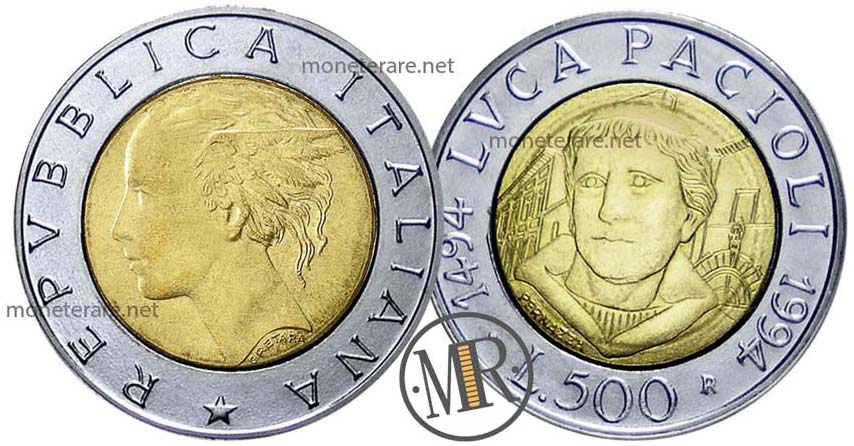
In 1994, a new version of the 500 Italian bimetallic lira was minted to commemorate the 500th anniversary of the publication of Luca Pacioli’s “Summa de arithmetica, geometria, proportioni et proportionalità”.
Fra Luca Bartolomeo de Pacioli is recognised as the founder of accountancy. He was an Italian mathematician, economist and religious, famous for developing the ‘double-entry bookkeeping’ method of accounting.
Description 500 Lire italiane 500th Anniversary Luca Pacioli Coin
The obverse features the usual female profile.
The reverse of these commemorative 500 lire bimetallic coins features a bust of Fra’ Paccioli with architectural elements of Sansepolcro, his home town, and the signature of Uliana Pernazza, author of the reverse, in the bottom left-hand corner.
On the outer circular crown of these 500 bi-metallic lire, also on the reverse, is the inscription 1494 LVCA PACIOLI 1994 and the value L.500.
Authors:
- Laura Cretara (Obverse)
- Uliana Pernazza (Reverse)
Value 500 Lire 500° Pacioli
- These 500 lire bimetallic coins commemorative Italy Luca Pacioli, are classified as common, so their value, even in FDC quality, comes to about 5 €.
500 lire coin 1996 – ISTAT
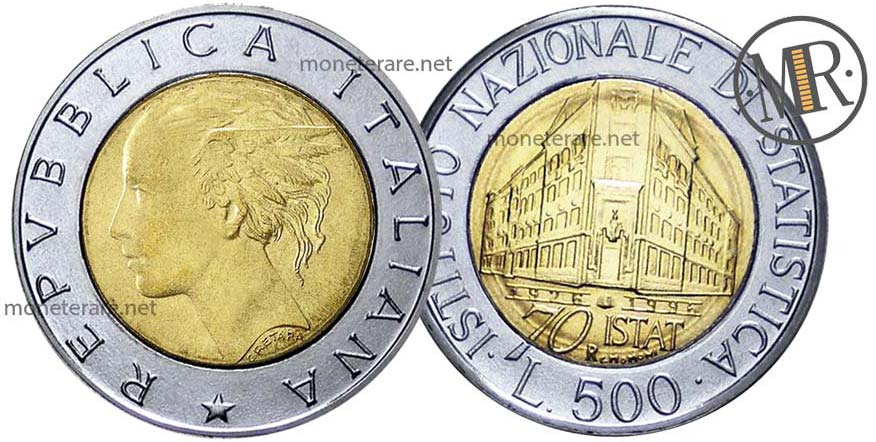
It was not until 1996 that a new commemorative 500 lire bimetallic coin was issued. The occasion for this issue was the 70th anniversary of the founding of the National Statistics Institute.
Description Italian 500 lire coin 70° ISTAT
As with the other 500 bimetallic lira, the figure on the obverse remains unchanged.
While on the reverse, the central portion of the coin features a perspective representation of the National Statistics Institute building.
Underneath the building are the dates 1926 and 1996, and further down ’70 ISTAT’, the mint mark and the signature of the author Claudia Momoni.
The outer ring bears the words ISTITUTO NAZIONALE DI STATISTICA and L.500.
Authors:
- Laura Cretara (Obverse)
- Claudia Momoni (reverse)
Value 500 Lire ISTAT Bimetallic
- These 500 commemorative bimetallic lira Italy, ISTAT, are also classified as common, so their value is around 3€.
Italian 500 lire coin 1997 – 50° Polizia Stradale
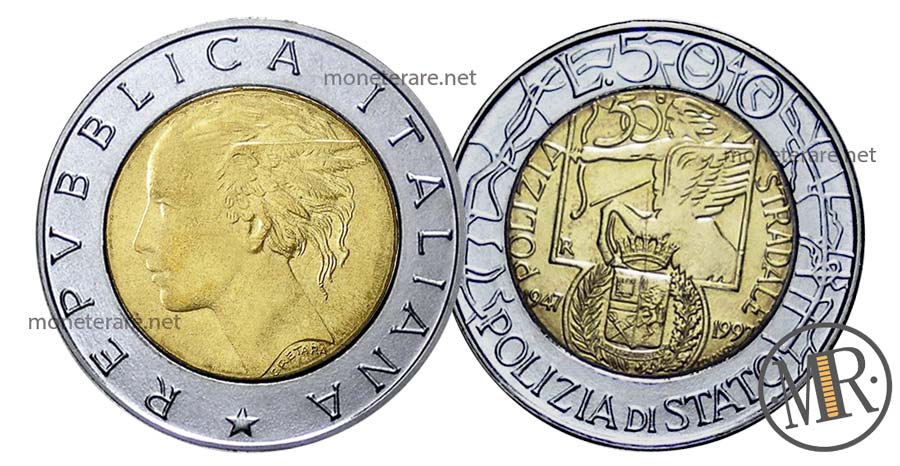
In 1997, on the occasion of the 50th anniversary of the creation of the Traffic Police, a commemorative bimetallic 500 lire coin was minted.
Description Italian 500 lire coin Polizia stradale
As with the other 500 lire bimetallic coins, the obverse remains unchanged, while the reverse is much more intricate.
The inner circle in Bronzital on the reverse side features a centaur (symbol of the Traffic Police), the mint mark R in the bottom left corner and “50°” in the top left corner.
Beneath the frame is the coat of arms of the Traffic Police between the two dates 1947 and 1997, while at the edge of the inner circle is the inscription ‘POLIZIA STRADALE’. Finally, the signature of the author of the reverse, Maria Carmela Colaneri, is at the bottom right.
On the Acmonital crown we find at the top the value L.500 superimposed on a street grid, at the bottom ‘POLIZIA DI STATO’.
Authors:
- Laura Cretara (obverse)
- Maria Carmela Colaneri (reverse)
Value of Italian 500 Lire Polizia Stradale Coin (50th Anniversary)
- The 500 lira Polizia Stradale (Road Police) of the Italian Republic, minted in 1997 to celebrate the 50th anniversary of the founding of the Road Police, are worth a maximum of €3 as they are classified as common.
Bimetallic Italian 500 lire coin 1998 – IFAD
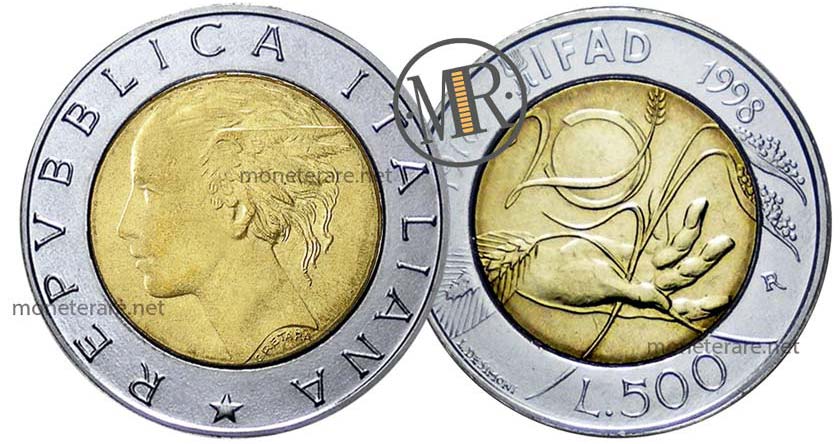
In 1998, a new commemorative 500 lire bimetallic coin was minted in Italy to celebrate the 20th anniversary of the International Fund for Agricultural Development (IFAD).
Description Italian 500 lire coin 20th anniversary IFAD
On the obverse, as always, the female profile of the personification of the Italian Republic.
The reverse of this 500 Lira coin depicts a hand holding an ear of wheat and an ear of sorghum, surmounted by the Ifad 20th anniversary logo.
In the outer circle we find the signature of the author Luciana De Simoni in the bottom left corner, followed by the value L.500 and the mintmark. Above the mintmark and the inscription IFAD are contained by the dates 1978 and 1998.
Authors:
- Laura Cretara (obverse)
- Luciana De Simoni (reverse)
Value of Italian 500 lire coin IFAD (20th Anniversary)
- With a mintage of 100,000,000, the 500 lire bimetallic 20° IFAD coin is graded C and may be worth, if FDC, 3€.
Italian 500 lire coin 1999 – Elezioni Europee (European Elections)
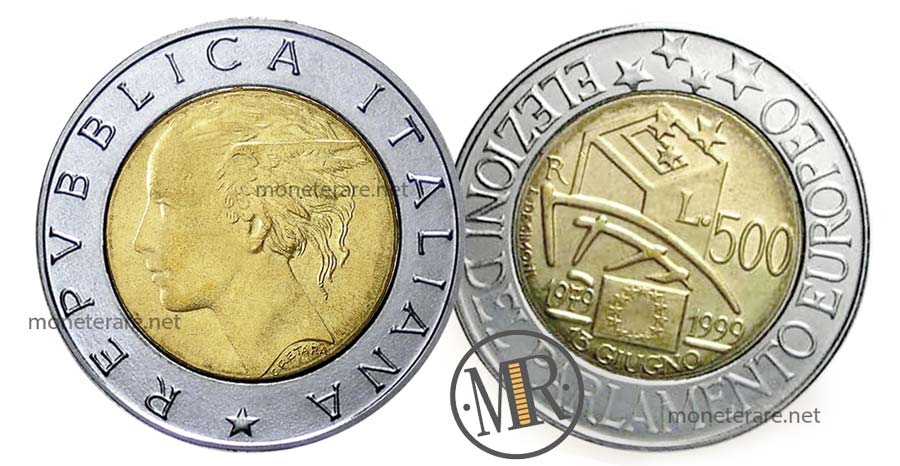
The last of the 500 lire bimetallic commemorative coins to be minted by the Italian Republic is the one issued to mark the 20th anniversary of the 1999 European elections.
Since 1979, elections for the European Parliament have been held every five years.
Description Italian 500 lire coin 1999 – Elezioni Europee
On the obverse, the usual profile of a woman drawn by Cretara.
The circular acmonital crown on the reverse of the 500 lire bimetallic 20° European Elections bears the inscription “ELECTIONS OF THE EUROPEAN PARLIAMENT” and at the top some stars which, going downwards, enter the inner bronzital circle.
In this one is an electoral urn from which the stars (7 stars) come out, with the mint mark on the left and the value L.500 on the right. Below the urn is a stylised representation of the European Parliament hemicycle and the European Union flag between the dates 1979 and 1999.
Under the flag the inscription ’13 June’ and on the left the signature of the author of the reverse Luciana De Simoni.
Authors:
- Laura Cretara (obverse)
- Luciana De Simoni (reverse)
Value 500 Lire Coin – 20th Anniversary of European Elections 1999
- The value of these commemorative 500 European Elections bimetallic lira, given that the print run is smaller than the others (50,000,000) can reach 4€, although the coin is still classified as common.
The value of the 500 Commemorative Bimetallic Lira Coins
Here is the table with the values for each Commemorative coin, divided by years.
Other types of 500-Lira coins
500 Lire Coins Republic of San Marino
The 500 bimetallic lira was not only minted in Italy, but also by the Republic of San Marino, from 1982 to 2001.
Unlike the 500 lire bimetallic coins of the Italian Republic, the obverse and reverse representations of San Marino coins were changed for each year of minting.
We soon talked a lot about these bimetallic coins in a dedicated article you can find here: 500 Lira San Marino coins.
Bimetallic 500 Lire of Vatican City
Also the Vatican City, from 1982 to 2001, minted some 500 lire bimetallic coins. We have talked a lot about them here: 500 lire Vatican City Bimetallic Coins.
Italian Silver 500 lire coin
From 1958 to 1967, 500 lire silver coins were minted in Italy. There are three types, called “Caravelle”, “Centenary of Italian Unity” and “Dante Alighieri”.
In particular, the 500 lire silver coins with the Caravels with the little flags against the wind are among the rarest and most precious coins of the Italian Republic.
Didn’t find what you were looking for? Check out these topics about lira coins:
- Here you can find out everything about the 1 lira coin, 2 lira coin, 5 lire coin, 10 lire coins , 20 lire and 50-lira coins.
- The 10 lira cents are here, the 20 lira cents here, and the 50 lira cents here.
- If you are looking for the 1 cent lira coin, look here and here on the 2 cent rare lira and 5 cent lira.
- Look here If you want infos about the 100 Lire coins and also the value of the 1000 Lira of the Italian Republic.
- We have discussed the 200 lire coins and their value here.
- We have talked about Telephone Tokens worth 200 lire on this page.
- We also talked about the 500 silver lira coins, the 500 bimetallic lira and the 500 lire banknotes.

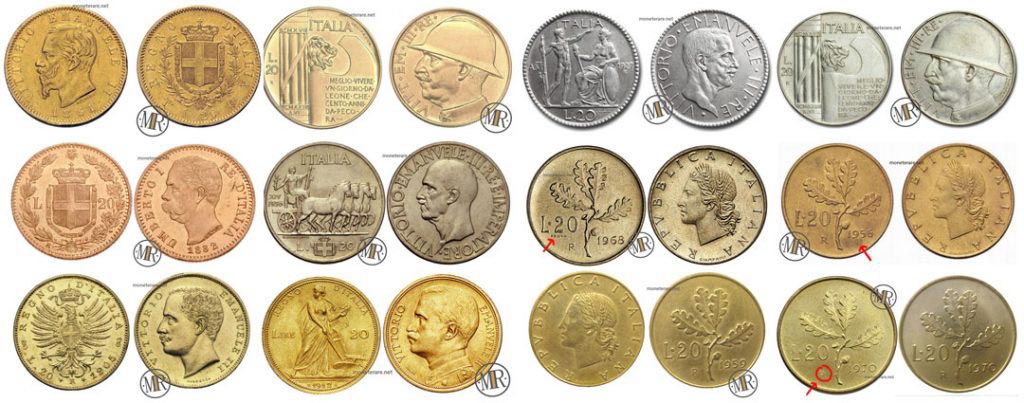

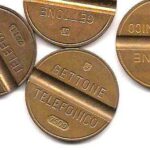
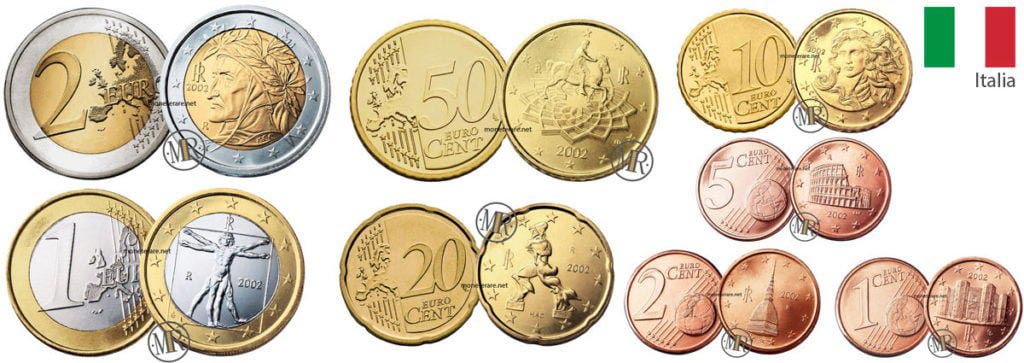
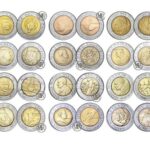
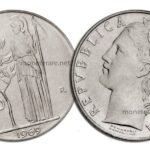
hello,
thank you for this interesting and informative article . I have two unopened uncirculated paper rolls of italin coin. One contains 25,000 lire of 500 lire pieces dated 1982. The other roll also unopened contains 10,000 lire of 200 lire pieces.
I.e. 50 coins in each roll. Is it possible to value these without opening the rolls? And, does the fact that the coins are in the original paper rolls impart any additional value? Thankyou. Carlo C
Hi have some italian coins